A typical Canal du Midi view. All photos on this post: Leica M9 Summilux 21mm
The Canal du Midi is more than just a convenient way to get from the Med to the Atlantic by boat, it is also extremely beautiful and despite its age, most efficient. The max speed in the canal is just 8 kmh and with about 20 minutes per lock the average speed works out at about 4 kmh which is no more than a pleasant walking pace. You might think that you’ll never manage to do the 400 kms of its total length at that speed but even taking it relatively easy it can easily be done in two weeks.
If you love nature, peace and quiet, culture and history you will love the Canal du Midi. It was built 350 years ago and you will be amazed at the way it works. It really is a very impressive piece of engineering indeed and not a day went by when I did not reflect on the imagination and the foresight of the people who had the courage to make it happen all those years ago.
Most of the locks on the Canal du Midi are oval like this one. It works on the same principal of an arch. The idea being that it stops the lock walls collapsing when there is no water in them to support them.
The Canal du Midi was originally designed with commerce in mind and it was used to transport such commodities as wine, grain and fuels using barges pulled by horses. These barges, or Peniche as they are called in French were originally made of wood but more lately in steel. There are very few wooden ones left and almost all of the peniche on the Canal du Midi have been converted to house boats or tripper boats. Today the Canal du Midi is no longer used for transporting goods.
The way the French solved the many issues of just how to take a waterway through the whole country is fascinating. At the summit, some 650 feet above sea level are three lakes which feed the canal with the water that it needs and even today the canal is rarely short of water thanks to this. Along almost the entire length of the Canal du Midi were planted trees. These trees serve many purposes. The leaves provide shade from the southern French sun so that the horses did not over heat and reduce evaporation from the strong Midi summer sun but more than that, their roots hold the banks together and the leaves that fall line the canal bed and help to waterproof it.
Every now and then we’d come across a line of dead trees like these.
Most of the trees today are plane trees which were planted about 150 years ago to replace the original trees which were mostly fruit trees. Today the trees are under threat from a fungus which is killing them off at a disturbing rate. I asked many of the lock keepers (eclusiers) about it and received a different answer each time. Some said that the fungus came over during the war in the wooden cases that the Americans used to hold ammo but however it got here the results of the fungus are clear to see in the many dead trees along the way. Quite how the fungus is passed from one tree to another is not clear either.
Some eclusiers said that the fungus is in the water, others said that it was caused by people tying up to the trees and then spreading the disease when they subsequently tied to another tree further down the way. However this doesn’t seem very likely as many of the trees that are affected are on corners and in other places where it is very unlikely that anyone has ever tied to them. More likely is that the fungus is carried in the water. This is born out by the fact that after the summit at Toulouse headed towards the Atlantic most of the trees are fine as the fungus cannot climb beyond the summit as the flow of water is always downwards. Some said that it was the spikes that people use to tie their boats to the banks and in many of the locks in affected areas there were pots of disinfectant that you are supposed to wash your spikes in before using them somewhere else.
In the round lock at Agde.
There were occasional signs at the effected areas instructing canal users not to tie up but since no one really knows what to do about it, all the measures are somewhat half hearted. It seems that the only remedy is to replace the trees with a more resistant species. The problem with this is that the old tree needs to be removed which in itself is no mean feat as many of these trees are a century and a half old and are a good 100 feet high! And the entire tree, roots and all needs to be removed before a new tree can be planted. One lock keeper said that it costs about 1000€ to replace one tree and if this is true the cost of doing so along the entire 400 km length of the Canal du Midi equates to one massive and hugely expensive project. I estimated that there are about 400 trees per one km so as you can see this could be a serious problem.
One wonders how the government will be able to justify such a huge expense when the canal is no longer used by commercial traffic. We paid just 66€ for a months stay in the canal which is nothing at all. It’s not the dues from the pleasure boats that will raise the money to replace the trees.
Just one of the many narrow and low bridges on the Canal du Midi. Maximum air draft is 3 metres.
In an effort to reduce the cost of running the Canal du Midi many of the locks have been automated whereas before, every lock had a resident eclusier. The VNF (Voies Navigables de France) who run the Canal du Midi and the other canals in France have also managed to delegate much of the maintenance of the canal banks to another department who have created a fabulous cycle lane that runs the entire length of the canal and I’m delighted to say that not one day went by when we did not see a number of cyclists using the pathways.
According to many sources the Canal du Midi attracts 10,000 boats and two million visitors annually. I don’t know where they get those figures from but I would be amazed if there were that many boats in or using the Canal du Midi. The Canal du Midi is a UNESCO site but will this be enough to save the canal? An estimated 210 million € is needed to replace the trees.
Chugging across one of the many aquaducts on the canal This one carries the canal over a river.
Anyway, enough of the sad news. It is my hope and belief that the Canal du Midi is too important and too beautiful for it to ever fall into disrepair. One way or another the trees will be replaced and it will go on for another 350 years at least. Let’s talk about the nice things.
If you love birds you will love the Canal du Midi. Because you are chugging quietly along you do not disturb the birds who nest in the trees. A sharp eye, a good pair of binoculars and a bird book are all that needed. In the two weeks we were in the canal we saw over 10% of all the bird species in France. That’s over 50 species!
The mad and slightly hectic 7 lock ‘staircase’ at Bezier. This section is the busiest of the entire canal. Note the two ‘bumper boats’ on the right.
There are a lot of birds of prey in the canals and we once saw a buzzard swoop down to the surface of the water and grab a fish. Another time we saw a parent feeding a chick in the nest, and another we saw a buzzard fly down to the water’s edge and take a drink. We saw herons (grey, night and purple) we even got to see a Roller fly into its nest hole in a tree. One morning we were woken by the wonderful call of a Golden Oriole.
Leaving the tunnel at Malpas. This tunnel was dug entirely by trained badgers.
Asides from the stunning bird life there are also all sorts of other creatures such as dragon and damsel flies, fish in the canal, frogs, water snakes and butterflies.
If nature’s not your thing then there are no end of fabulous and historic sites to see since the canal runs through some spectacular towns along the way, each with its own regional speciality. We stopped in Carcassonne where we had a genuine cassoulet. Where ever possible we always like to sample the local fare.
A strange metal sculpture with a head made from a camping gaz bottle for sale at one of the locks.
So you fancy having a go? What kind of boat is best? Well, you can do the trip in a yacht with the mast down but if you draw more than 4 feet or 1.2 metres you may have a few problems. They say that a boat drawing 150 cm can make the trip but we draw 120 cm and we had some moments that were touch and go. At the entrance to the Canal du Midi at the Etang de Thau we were skimming the bottom. We could feel the boat rise up and slow down. A load of throttle saw us get by but I don’t think a boat drawing more than us would have managed. There is no shortage of water in the canal, at least there was not this year (2012) as there had been a lot of rain. All the sections of the canal were as full as they could have been but despite that the waters were shallow. I guess that the canal needs regular dredging now that the peniche no longer pass through.
The amazing fortified Cité of Carcassonne.
We did the trip in a yacht but if I was going to do this again I would prefer a motor boat with rubber fendering all over. The biggest problem we had was getting to the bank when we wanted to stop. There is depth in the centre of the canal but it shelves quickly at the sides and we just couldn’t get close enough to tie up. Fortunately there was usually a dedicated waiting pontoon outside every lock that was built out away from the bank a little and this is where we generally stayed.
When we first did the canals I fendered the boat up completely and had fender boards the lot. This last time we just used the boat’s normal fenders placed only on the port side which was adequate if we took care. What I would suggest is as many fenders as you can get and put a fat ball fender on each corner then you should have no problems. A fender board would be a good idea especially if it can double up as a boarding plank. That way you can moor close to the bank and still get ashore.
Doolittle tied up for the night on a pontoon outside a lock. Navigation ceases at 19-00 so you are assured of a quiet night.
You’ll need spikes to drive into the ground if you plan to tie up along a bank. But make sure you clean them in the tubs provided at each lock to prevent spreading the fungus that is killing the trees. A pair of ropes twice the length of your boat will be more than adequate for the Canal du Midi. Use old lines as they do get quite scuffed and dirty when rubbing on the lock walls. Other than that you need no special equipment.
A triple staircase lock. Unusually the eclusier left all the gates open so as the water entered it rushed down. Click on this image to see it bigger. It was a bit scary although there wasn’t as much turbulence as you might have imagined.
There are numerous Halte Nautiques along the way which cost about 5€ a night and often have water and electricity and other facilities such as showers and Internet (wifi). Fuel was hard to find and existed only in Toulouse as far as we could tell. Mind you economy was good with the engine barely above tickover for most of the time. We stocked up on most food before we left and only needed to top up the supplies from time to time. Most French towns and villages have a small shop or a market where you can get good stuff.
Picking wild cherries from the many trees along the banks (June) These cherries were excellent. We picked over a kilo and a half in all.
In all there are over 100 locks to negotiate between Agde and Bordeaux. About half of them are going up and about half are going down. Each lock raises (or lowers) the canal by about ten feet, although some of the locks do slightly less. Like most things in life going down is easier than going up. It is certainly easier to descend in a lock than to ascend as there is no turbulence so it’s all very mellow. There are tricks to make going up easier though and one of those is to make sure you are at the back of the lock. Often if we were with other boats we would let them go first. ‘How kind’ they must be thinking. Those English are so polite. Ha! Little did they know.
Lovely rainbow at dusk.
A yacht with a keel is far more susceptible to being thrown around when a lock is filling and often it depends on the lock keeper. Some seem to operate them with more understanding. Some just open all the valves all at the same time and that can make it interesting. Even the most violent locks were not really a problem. Here’s how it works.
As you approach a lock (when ascending), drop a crew member off on the bank. There is usually a pontoon a few hundred metres before all the locks. The crew member then takes the lines which are throw from the boat. The lines are placed around a bollard and dropped back to the crew member/s on the boat. We usually used the same bollard for both ropes. In other French canals there was usually a ledge and a staircase just outside the lock where a crew member could be dropped off when entering the lock but there are no locks like this on the Canal du Midi. When going down you enter a full lock so you don’t need to drop anyone off.
Very strange to be motoring through a city. This is Toulouse.
The lock keeper will close the doors behind you using their remote control. This is a recent introduction. Before the eclusier had to stand in the same place and press buttons. Now they are free to roam. Whether this is safer is debateable as often the eclusier would simply open the sluices and bugger off. They would return some minutes later to let you out. I asked about the remote control units and discovered that they are neither waterproof nor do they float! I thought this very strange considering the environment they are used in.
All the locks are the same and yet different. What I mean by that is, sometimes they have a ladder on the left side, then all of a sudden it will be on the right. Sometimes there are poles that you can tie up to inside the lock, sometimes not. The bollards may be in the same place in each lock or they may not. You can be sure that as soon as you have got used to them being a certain way they will change when you least expect it.
A night time view of the canals. A four minute exposure. Note the movement of the stars and the calmness of the water.
Another new feature is the beeping of the doors when they open or close. This is probably a safety issue although if I lived in one of the old lock keeper’s houses which are often rented out by the VNF I would probably try and disable the annoying beep. I wonder why it’s always such an annoying sound. Why can’t they program it to play the sound of birds or cows? It seems so out of place in the tranquillity of the canals.
Twist the rubber hose that dangles over the water to set up the next lock.
Many of the locks are now automated. They are operated by a rubber pipe that hangs down over the canal that you must twist as you pass. Then you will see the lights change at the lock. When the light is green you enter. Nothing happens until you press the green button inside the lock. Then the doors close and the lock fills or empties. Simple and effective. Not once did we have a problem with any of the locks.
Another night time resting place.
Navigation in the summer is from 09-00 to 19-00 hrs. The manual locks are closed for an hour at 12-30 for lunch. The automated locks don’t stop for lunch however.
You have to pay to use the canals. We paid 66€ for a month. The tariff is calculated by the area of your boat. Considering that you can stop anywhere, this is the only cost apart from fuel so it represents extremely good value for money in my opinion. Less than 3€ a day seems to me to be a perfectly reasonable sum.
You’ll need to buy a vignette to prove that you have paid and thankfully this can now be done via the VNF website vnf.fr The site is in English but you’ll still need to use your brain a bit as the translation leaves something to be desired!
You also need to have a certificate of competence from the RYI which must include the ‘Inland Waterway’ category. These days you have to take a Cevni test. All details can be found on the RYI site. You can do a practice test before taking the actual one. It couldn’t be easier really although the costs soon mount up. What is interesting is that you do not need the Cevni test to get a vignette, nor will anyone ask for it along the way! In the five times over the last decade or so that we have ‘done’ the canals no one has ever asked to see my CoC. This time we did have a check up on our vignette which surprised the lock keeper as he told us he had never known anyone bother.
Idyllic is the word. Beautiful.
The only problems you are likely to have is when grass cuttings get into the water strainer and stop the water cooling the engine. Before you set off make sure you practice cleaning out the strainer. We got so good at it that we could cut the engine, shut the seacock, clean the strainer, open the seacock and get the engine going again all before the boat ran out of momentum.
The very best advice I can offer above and beyond all the boring practical stuff is that you MUST make an effort to speak French. Your entire experience will be VERY different if you do try. The French have a reputation for being arrogant but I can assure you this has not been our experience. Everyone, without exception was friendly and helpful and I am convinced this is because we speak French. If you can’t speak French, don’t worry. No one expects you to learn another language in a week but at least learn a few basic words like; Bonjour and Merci and when asking for help try and do it in French. When I first began I learned how to say ‘I don’t speak French very well’. The French always greet each other before asking a question so make sure you say hello first. Carry a small dictionary or phrase book at all times and whip it out at every occasion. They will be so impressed with your willingness to learn their language that they will bend over backwards to help you.
The lock keeper’s house at the last lock on the canal where it enters the River Garonne. Note the tide gauge on the front of the building. This door at the bottom is already 5 metres above the normal level of the river. The highest it has been reaches the top of the stairs!!!! That’s 13 metres above normal levels. It is simply impossible to comprehend that amount of water.
I can’t stress this enough. Your whole experience in the canals will largely depend on you making an effort to speak French. It’s to your benefit.
Passing through the ‘bridge of death’ as I call it. We were spat through at over ten knots such is the current!
You don’t have to have your own boat as you can hire a ‘penichette’ from any number of boat hire companies in all the canals. The canals are a very mellow place to be. Sometimes you need some patience and it does not pay to be in a hurry. You need to chill out and take what comes. If the lock keeper tells you that the lock is broken and they don’t know when it will be fixed. Simply tie up your boat and read a book, go for a walk or a cycle ride.
Plenty of water this year. A typical view of the lock doors from the boat.
When you consider just how crowded the world is these days and how fast and hectic, it may come as a surprise that the canals can be so quiet and little used. No matter what your age I would heartily recommend a canal trip as a holiday.
Here are some helpful links to get you started.
http://en.wikipedia.org/wiki/Canal_du_Midi
http://whc.unesco.org/en/list/770/
http://www.guardian.co.uk/world/2011/aug/13/canal-du-midi-under-threat
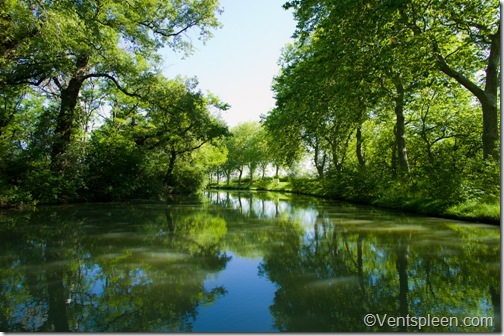
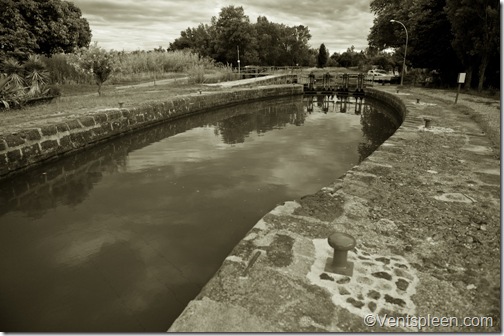
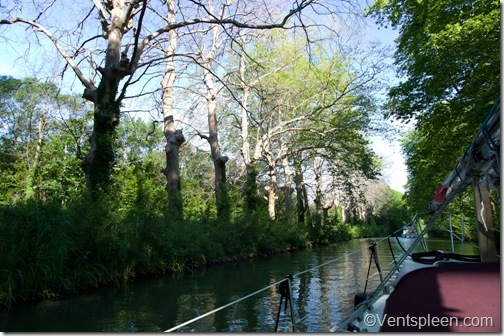
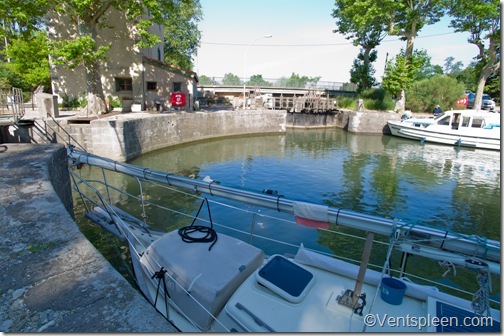
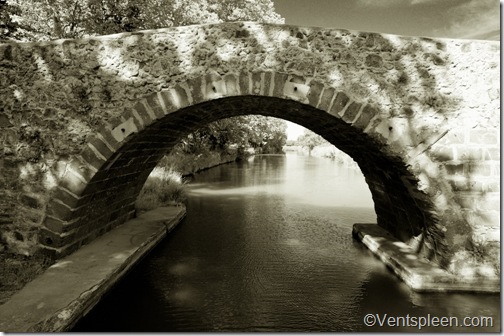
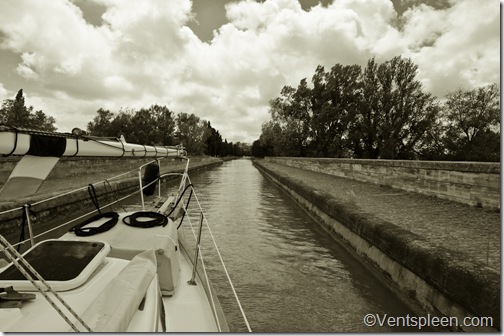
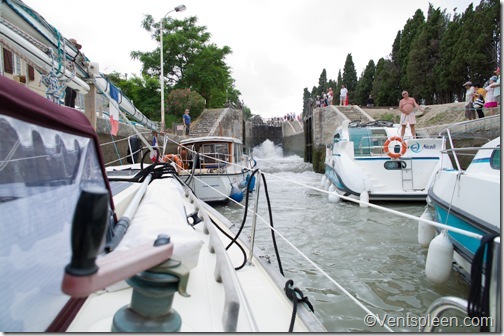
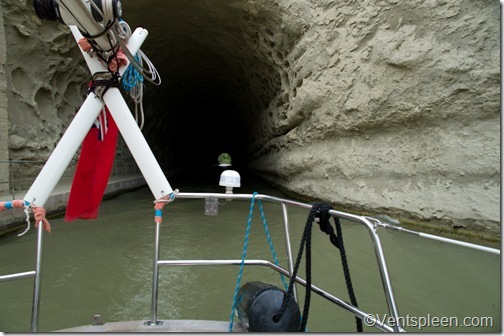


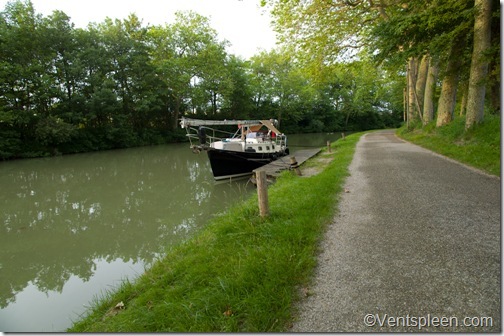
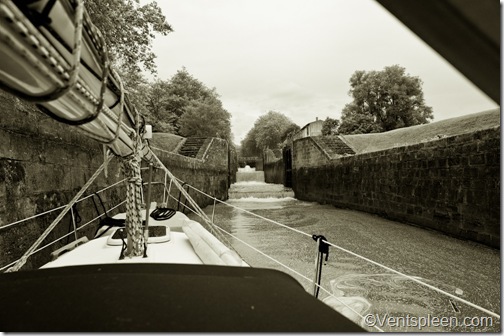
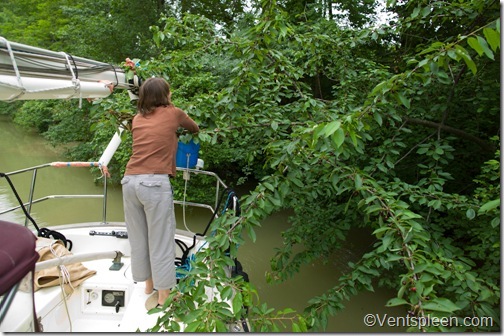
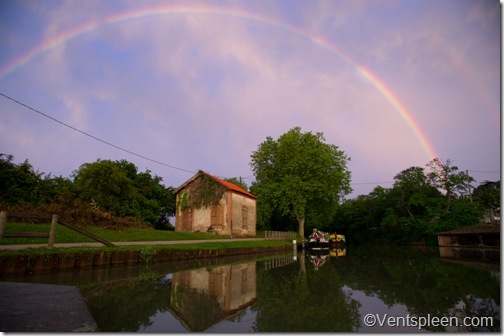
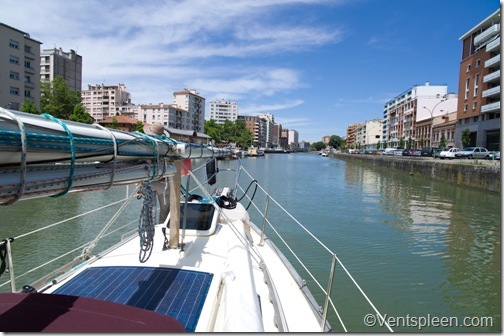
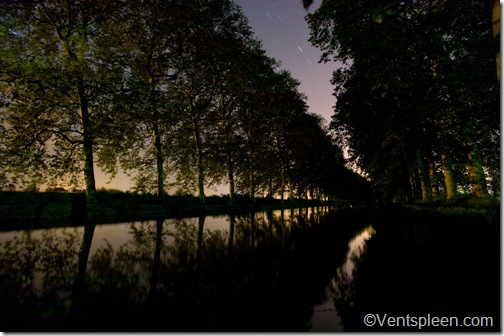
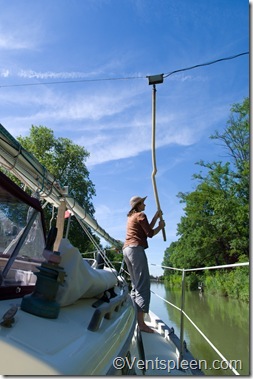
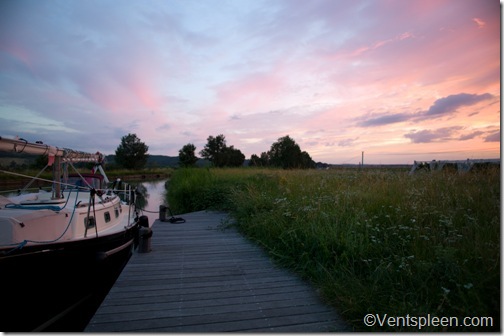
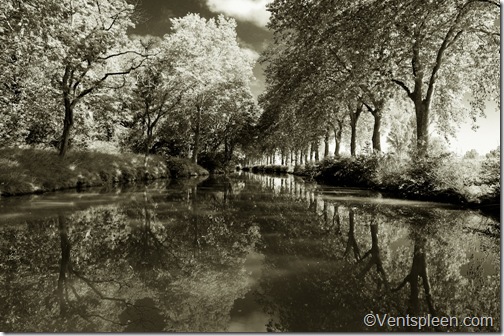
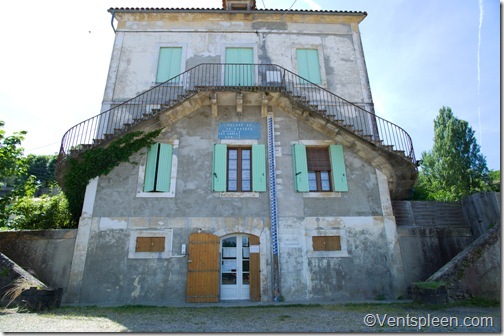
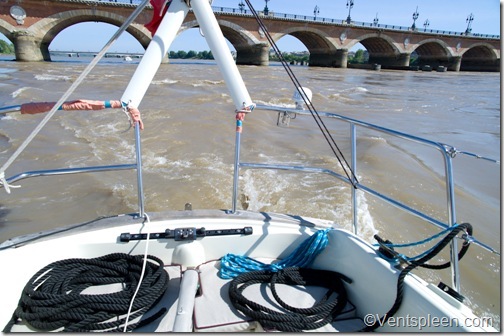
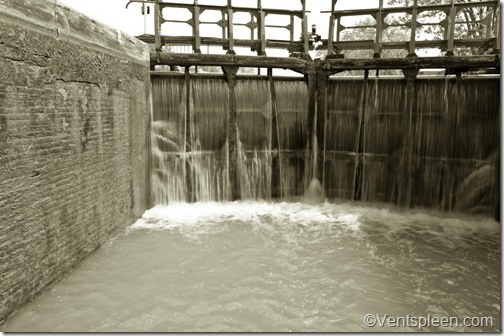
Ha trained Badgers indeed!
Now if you had said it was trained French Beaver instead of Badger that would have been a little more believable, having personal experience with several of the species, I can vouch for their power and if (which I would have thought impossible) they could be tamed and trained, mountains could be moved, let alone relatively small tunnels…
I got the live commented version of this post on board Doolittle! Lucky me! Motivated to give it a go now. I believe the 10,000 boat figure because traffic just does not stop. Tourists from May to October but all year round sail boats pass through. Quite big centreboard boats. Not many with a keel that is for sure.
Do the eclusiers take your lines when ascending? I imagine that on the decent you can get ashore and take a turn on a bollard or similar, but that can’t be possible on ascent.
Ahoy Justin,
Generally the lock keepers won’t take your lines but they probably would if you asked. That won’t help you in the automated locks of course where there are no lock keepers. The accepted practice is to drop a crew member off before the lock to catch lines.